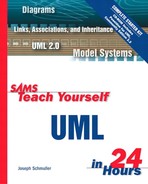It's all about vision. A complex system comes into being when someone has a vision of how technology can make things better. Developers have to fully understand the vision and keep it firmly in mind as they create the system that realizes the vision.
System development projects are successful to the extent they bridge the gap between visionary and developer. The Unified Modeling Language (UML) is a tool for building the bridge. It helps you capture the vision for a system and then enables you to communicate the vision to anyone who has a stake in the system. It does this via a set of symbols and diagrams. Each diagram plays a different role within the development process.
The goal of this book—for all three editions—is to give you a firm foundation in the UML in 24 hours of study. Each hour presents examples to strengthen your understanding, and most of the hours provide exercises that enable you to put your newfound knowledge to use.
In preparing this edition, I went through the first two and tightened up the prose, adding and updating material where necessary. Some of the additions were necessary because of UML 2.0, the newly adopted version. Others were necessitated by the passage of time and the advancement of technology.
As in the first two editions, Hour 14, “Understanding Packages and Foundations,” presents theoretical concepts at the foundation of the UML. In this edition, I've expanded this hour considerably in order to accommodate new concepts from UML 2.0.
I've refined some of the thinking behind the models and diagrams and added quiz questions and exercises. As part of the refinement, in this edition I precede every interaction diagram with a class diagram that shows the operations of the classes. The goal is to clarify the messages that appear in the interaction diagrams and make them more intuitive. If you know a little about the UML, you'll understand what I just said. If not . . . well, then . . . you won't. By the end of the book, however, I'm certain you will.
This book is aimed at system analysts, managers, designers, and developers who have to quickly master the fundamentals of the UML. If you have to start working with the UML immediately, or if you have to know the UML enough to understand the work of others who use it, this book is for you.
The book is in three parts. Part I, “Getting Started,” gives an overview of the UML and then moves into object-orientation, which forms the foundation concepts for diagramming objects and classes. I examine the use case—a construct for showing how a system looks to a user—and then show how to diagram use cases. I spend extra time on the concepts behind object-orientation and use cases, because these two ideas form the basis for the parts of the UML you're most likely to use most of the time. The remaining hours in Part I get you working with the rest of the UML diagrams.
Part II, “A Case Study,” presents a simplified methodology for development along with a fictional case study. Thus, the hours in Part II show how the UML fits into the context of a development project. You'll see how the elements of the UML work together in a model of a system.
Part III, “Looking Ahead,” shows the application of the UML to design patterns and embedded systems and then examines its application in a couple of other areas.
Numerous vendors provide software packages that enable you to create UML diagrams and coordinate them into a model. In Appendix B, “Working with a UML Modeling Tool,” I give you an idea of what it's like to work with one as I walk you through the creation of three UML diagrams in Microsoft Visio Professional Edition. I also briefly address three other modeling tools.
For Parts I–III, however, all you'll need are pencil and paper to draw the diagrams, and a healthy curiosity about how to use models as a foundation for system design.
As you read through this book, you'll see that
Each hour begins with a “What You'll Learn in This Hour” list.
New Terms appear in a special font. Here's an example:
Extending downward from each object is a dashed line called the object's lifeline.
Throughout the book, a special sidebar element presents useful information that's somewhat off the main flow:
Let's start modeling!
